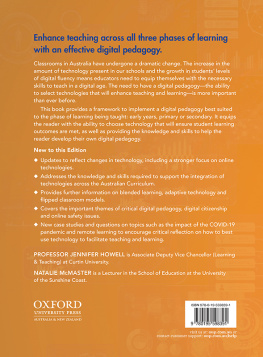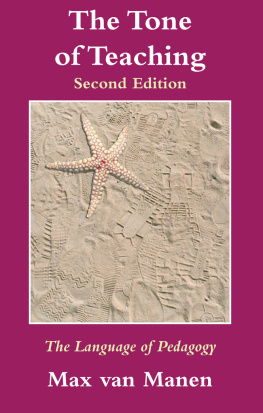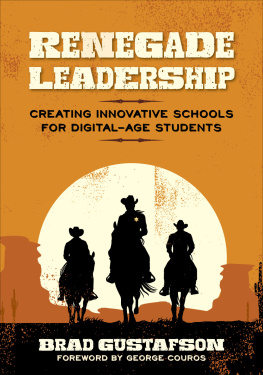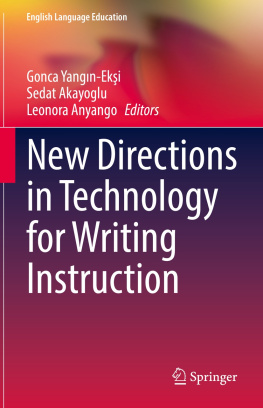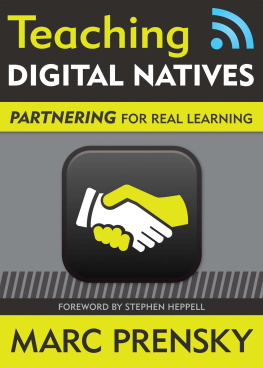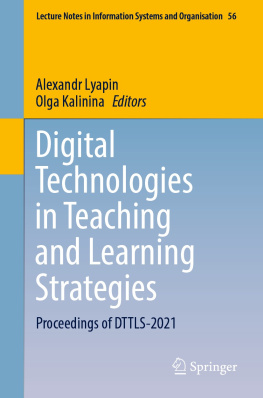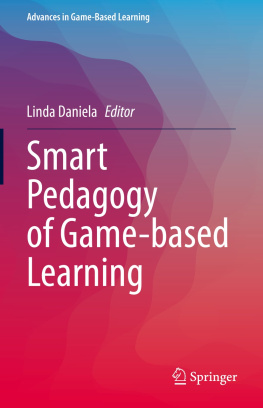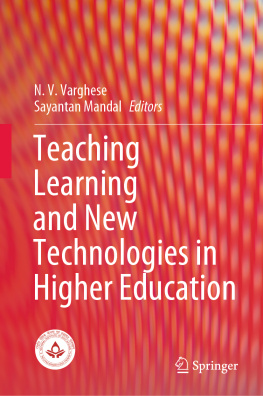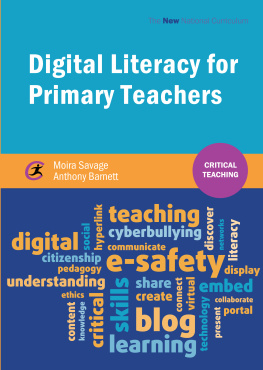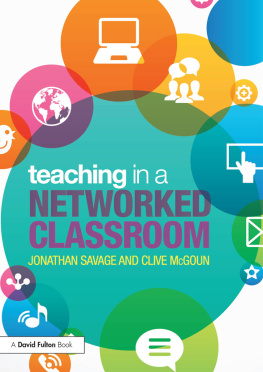Table of Contents
Page List
Guide
Teaching with Technologies
Dedication
To R and K Howell. You continue to inspire me every day, thank you.
Jennifer
To all the Js in my life, Jamie, Jackson, Josh and Jess. Thank you for the patience and support you give to all my endeavours.
Natalie

Oxford University Press is a department of the University of Oxford.
It furthers the Universitys objective of excellence in research,
scholarship, and education by publishing worldwide. Oxford is a registered trademark of Oxford University Press in the UK and in certain other countries.
Published in Australia by
Oxford University Press
Level 8, 737 Bourke Street, Docklands, Victoria 3008, Australia.
Jennifer Howell and Natalie McMaster 2022
The moral rights of the authors have been asserted
First published 2012
Second edition 2022
All rights reserved. No part of this publication may be reproduced, stored in a retrieval system, or transmitted, in any form or by any means, without the prior permission in writing of Oxford University Press, or as expressly permitted by law, by licence, or under terms agreed with the reprographics rights organisation. Enquiries concerning reproduction outside the scope of the above should be sent to the Rights Department, Oxford University Press, at the address above.
You must not circulate this work in any other form and you must impose this same condition on any acquirer.

ISBN 9780195598391
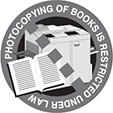
Reproduction and communication for educational purposes
The Australian Copyright Act 1968 (the Act) allows educational institutions that are covered by remuneration arrangements with Copyright Agency to reproduce and communicate certain material for educational purposes. For more information, see copyright.com.au.
Edited by Camha Pham
Typeset by Integra Software Services Pvt. Ltd.
Proofread by Newgen KnowledgeWorks Pvt. Ltd., Chennai, India
Indexed by Puddingburn Publishing Services Pty. Ltd.
Printed in Hong Kong by Shek Wah Tong Printing Press Ltd.
Links to third party websites are provided by Oxford in good faith and for information only.
Oxford disclaims any responsibility for the materials contained in any third party website referenced in this work.
CONTENTS
JENNIFER HOWELL AND NATALIE MCMASTER
JENNIFER HOWELL AND NATALIE MCMASTER
JENNIFER HOWELL AND NATALIE MCMASTER
JENNIFER HOWELL AND NATALIE MCMASTER
JENNIFER HOWELL AND NATALIE MCMASTER
ALI BLACK AND JENNIFER HOWELL
JENNIFER HOWELL AND NATALIE MCMASTER
JENNIFER HOWELL AND NATALIE MCMASTER
NATALIE MCMASTER
JENNIFER HOWELL AND NATALIE MCMASTER
MARTIN COOPER AND JENNIFER HOWELL
MARTIN COOPER
MARTIN COOPER AND NATALIE MCMASTER
LIST OF FIGURES
LIST OF TABLES
PREFACE
Technology has become an increasingly pervasive force in the modern world. Most aspects of our lives have undergone a technologising in recent years and the speed of change has been remarkable. In the 1980s, research began to emerge about the use of computers in education. Many working in the education profession were polarised into two distinct viewpoints: those who thought the addition of computers in the classroom were an exciting development, and those who feared their impact on teaching and learning. As a field, we have moved forward, and much research has been conducted to show the impact technology has on teaching, learning and student engagement. Technology itself has moved forward from the large desktop computers of the 1980s, to exciting smart devices that enable movement, collaboration and dynamic learning activities. Classrooms in Australia have undergone a dramatic change; in the past, technology might have been a shared movie projector or overhead transparency machine. Now, it is common to see classrooms equipped with smart televisions, laptops, iPads and internet access. Some schools have a laptop, iPad or Bring Your Own Device (BYOD) programs, where every student in the class has their own device to use for their learning. This increase in the amount of technology present in our classrooms has meant that educators have needed to equip themselves with the necessary skills to teach in a digital age.
The need to have a digital pedagogy is more important now than ever before. The need to have a suite of skills and experiences that will ensure teaching and learning activities are rich with technologies is vital. Students are habitually using technology in their personal lives at a far greater level than previous generations. They are experienced in a range of digital technologies such as smartphones, web browsing, platform games (e.g. Xbox), online gaming, Web 2.0 (e.g. social media) and popular apps. They expect their future professional lives to be rich with technology, and they expect their education to be likewise. A digital pedagogy should not be mistaken as a form of digital fluency, or the ability to use a wide range of different technologies. It is, in fact, the ability to select technologies that will enhance teaching and learning. We could all very easily use more technology in our teaching, but will they ensure learning outcomes are met? Have they supported the teaching? Have they enhanced the learning experiences of our students? An effective digital pedagogy will equip educators with the abilities to achieve all of these goals.
This book offers in-service and pre-service educators a digital pedagogy specifically designed for the different phases of learning they are practitioners in, whether early, primary or secondary. These three digital pedagogies have been customised to meet the needs of both educators and learners within these different phases of schooling. The digital pedagogies are grounded in theoretical underpinnings, some of which will be familiar to educators and some of which are specific to educational technologies. They offer a framework for educators to implement the use of technology in each phase of learning, provide detailed examples of different technologies and tie their use to the learning outcomes associated with each phase.
The journey towards becoming an educator who uses digital technologies in their teaching and learning is a complex one. It requires a commitment and energy to explore how current and emerging technologies may assist in teaching and learning. It is reliant upon educators possessing an inquiring mind, having a fearless attitude and being a creative practitioner. These are skills that should be present in all educators, across all phases of learning. This book has been designed to provide you with the necessary information to develop your own digital pedagogy, which is aligned to the needs of your students in the phase of learning within which you are working.
Outline of the book
introduces the idea of a digital pedagogy and explores why educators need to equip themselves with such a set of skills and practicesit explores the changing nature of todays students and the assumptions we have made about their levels of digital fluency. Finally, it examines the drivers behind the need for a digital pedagogy.

